Further education and skills inspections and outcomes as at 28 February 2019: main findings
Updated 21 September 2020
Applies to England
This release contains:
- provisional data for the most recent inspections and outcomes as at 28 February 2019
- provisional data for inspections conducted between 1 September 2018 and 28 February 2019
- revised data for inspections conducted between 1 September 2017 and 31 August 2018
Between 1 September 2018 and 28 February 2019 monitoring visits accounted for 57% of inspection activity, an increase of 35 percentage points compared with last year (see Figure 1).
Between 1 September 2018 and 28 February 2019, 148 providers had their first monitoring visit or inspection from Ofsted.
The proportion of good or outstanding independent learning providers (including employer providers) continues to decline.
Figure 1: Balance of inspections and monitoring visits, by reporting year
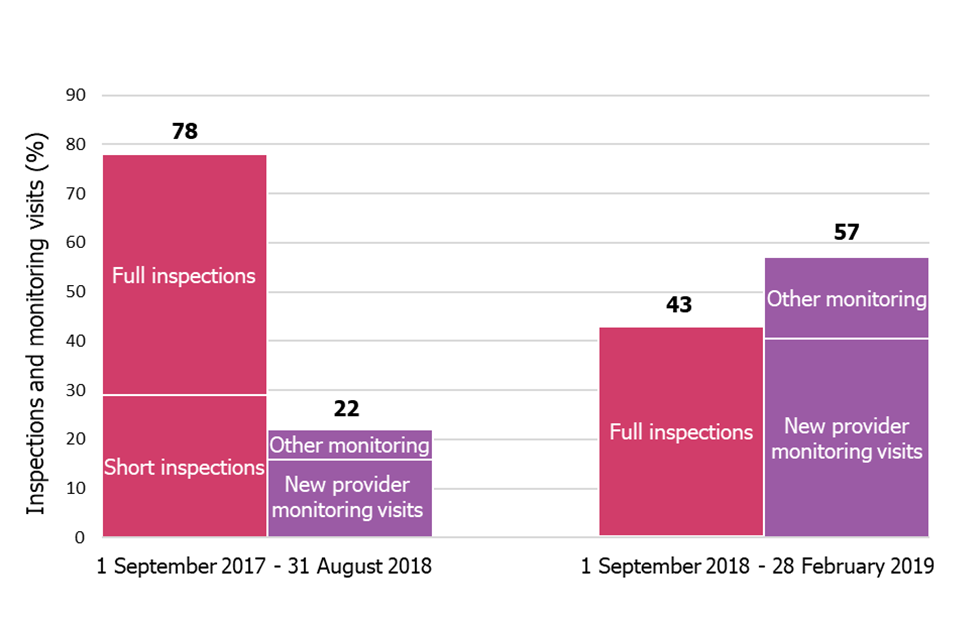
1. Providers and inspection volumes
1.1 Providers
The number of further education and skills providers has increased by 54% since August 2017.
On 28 February 2019, there were 1,796 open and funded further education and skills providers recorded on the Ofsted systems. This is 114 more than on 31 August 2018, and 628 more than on 31 August 2017, an increase of 7% and 54% respectively. This increase was largely due to the introduction of apprenticeship funding reforms in April 2017. The funding reforms have mostly affected independent learning providers (including employer providers).
The number of independent learning providers (including employer providers) has increased by 120% since 31 August 2017, rising from 491 on 31 August 2017 to 1,079 on 28 February 2019.
The number of general further education (FE) colleges continues to decline due to mergers. Between 1 September 2018 and 28 February 2019 there were 7 mergers involving general FE colleges; 5 between 2 general FE colleges and 2 between a general FE college and a sixth form college. As at 28 February 2019, there were 175 general FE colleges.
Between 1 September 2018 and 28 February 2019, 148 providers received a new provider monitoring visit or were inspected by Ofsted for the first time. As at 28 February 2019, 68% of the 1,796 open and funded further education providers had received a new provider monitoring visit or an inspection, 3 percentage points higher than as at 31 August 2018.
Figure 2: Proportion of further education and skills providers inspected or visited, over time
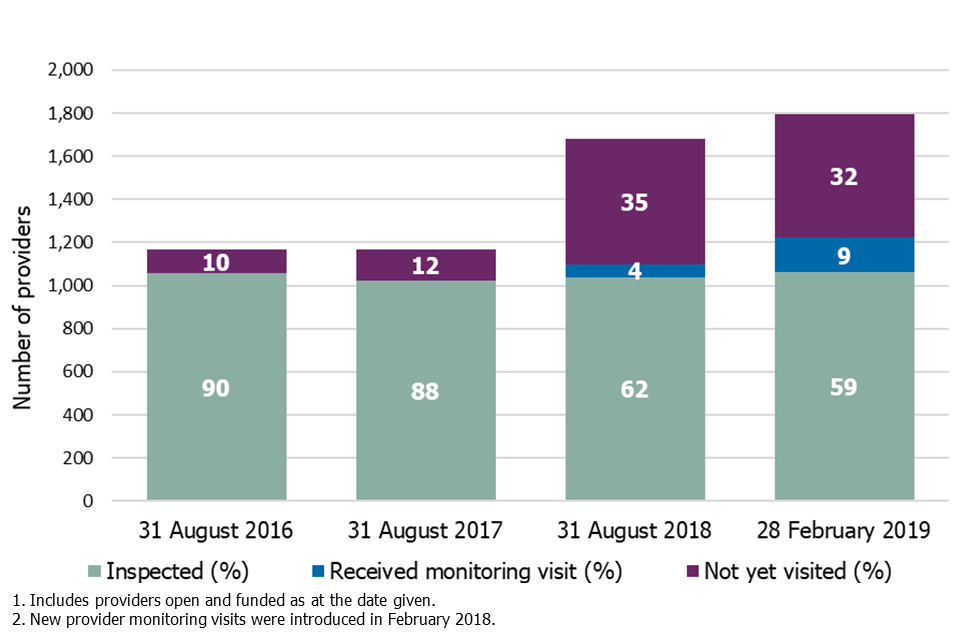
1.2 In-year monitoring visit volumes
Monitoring visits accounted for 57% of inspection activity.
In the 2 years before the introduction of new provider monitoring visits, monitoring visits usually accounted for around 10% of the further education and skills inspection activity in any given year. Between 1 September 2018 and 28 February 2019, they accounted for 57%. The 172 monitoring visits can be broken down as follows:
- 116 new provider monitoring visits to providers newly directly funded for apprenticeships
- 6 safeguarding visits, following an insufficient judgement for safeguarding at a new provider monitoring visit
- 50 other monitoring visits, including visits to providers previously judged requires improvement or inadequate, along with monitoring visits to newly merged colleges
1.3 In-year inspection volumes
Only 1 short inspection was carried out between 1 September 2018 and 28 February 2019.
Since the introduction of short inspections in September 2015, full and short inspections have accounted for, on average, nearly 90% of the further education and skills inspection activity in any given year. The remainder of the activity was made up of monitoring visits.
In September 2018 the Department for Education asked Ofsted to carry out monitoring visits to all newly, directly funded apprenticeship providers. As the first 3-year cycle of short inspections had concluded on 31 August 2018 and there had been a policy change to extend the short inspection cycle to 5 years, Ofsted was able to carry out a large number of new provider monitoring visits over the first 6 months of this reporting year. These changes have led to only 1 short inspection being carried out so far this reporting year and therefore, the proportion of full and short inspection activity has reduced to 43%.
Figure 3: Proportion of providers selected for inspection, by inspection type and reporting year

Between 1 September 2018 and 28 February 2019, 129 further education and skills providers were inspected. This included 58 independent learning providers (including employer providers), 24 general FE colleges, 11 community learning and skills providers, 9 higher education institutions, 7 sixth form colleges and 20 inspections of other provider types.
The 129 inspections can be broken down as follows:
- 55 full inspections of providers previously judged requires improvement or inadequate
- 29 risk-assessed full inspections of providers previously judged good or outstanding
- 42 full inspections of providers inspected for the first time
- 2 full inspections of outstanding providers subject to routine inspection[footnote 1]
- 1 short inspection of a provider previously judged good
2. Inspection outcomes
2.1 In-year inspection outcomes
The proportion of providers judged good or outstanding was 14 percentage points lower than last year due to the small number of short inspections during this period.
Between 1 September 2018 and 28 February 2019, the proportion of providers judged good or outstanding was 56%, 14 percentage points lower than during the last reporting year (1 September 2017 to 31 August 2018).
Historically, around 90% of the providers that received a short inspection in any given year (including those that converted to a full inspection) remained good or improved to outstanding. It is therefore not surprising that, without short inspections this year, the proportion of providers judged good or outstanding was much lower.
As we would expect, if you compare the outcomes from only full inspections the difference is less stark. Between 1 September 2018 and 28 February 2019, 128 providers had a full inspection, of which 55% were judged good or outstanding. This is 3 percentage points higher compared with last year.
Figure 4: Further education and skills providers’ full and short inspection outcomes, by reporting year
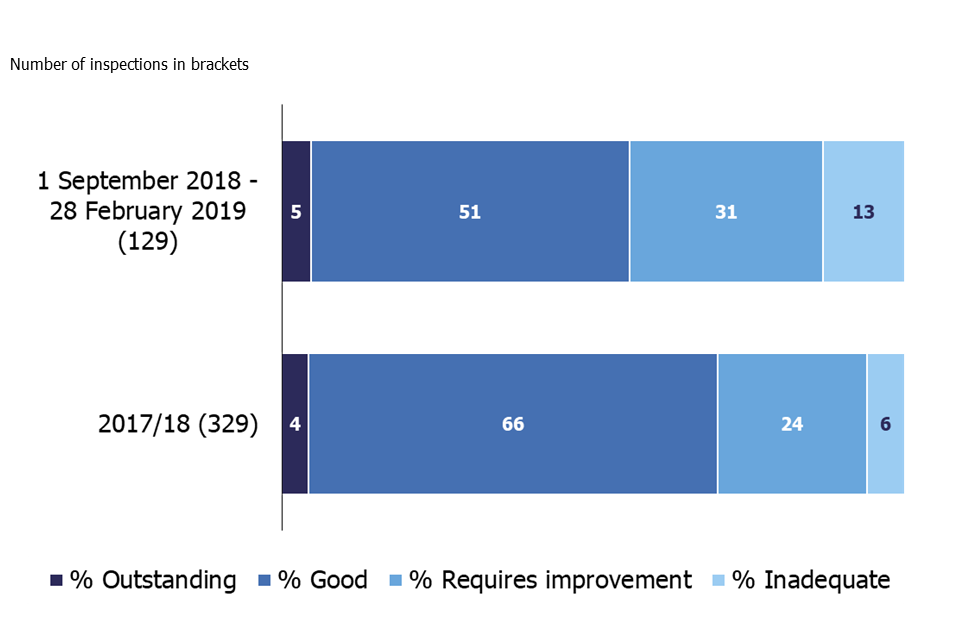
The providers judged to be good between 1 September 2018 and 28 February 2019 were made up of:
- 33 providers previously judged requires improvement which improved to good
- 16 providers that were inspected for the first time and were judged good
- 13 providers that were previously judged good and remained good (including 1 following a short inspection)
- 4 providers that were previously judged outstanding that declined to good
2.2 In-year safeguarding judgements
The proportion of providers inspected between 1 September 2018 and 28 February 2019 that had effective safeguarding arrangements in place was 94%.
Of the 129 providers inspected between 1 September 2018 and 28 February 2019, 121 had effective safeguarding arrangements in place for learners. Eight providers were judged not to have effective safeguarding arrangements in place. Four of these providers were previously judged requires improvement and had declined to inadequate at their re-inspection. The remaining 4 were inspected for the first time.
In the providers that did not have effective safeguarding arrangements in place, inspectors found:
- learners did not know how to keep themselves safe or who to contact should they need to raise a concern
- a failure to implement safeguarding policies and procedures to protect learners
- a failure to ensure adequate risk assessments had been carried out
- too few learners understood the risks of radicalisation and extremism
2.3 In-year monitoring visit outcomes
Three quarters of providers were making at least reasonable progress at their new provider monitoring visit.
All 116 new provider monitoring visits carried out were to independent learning providers (including employer providers). Overall, 74% of providers were making at least reasonable progress across all areas that they were assessed on during their new provider monitoring visit.
Table 1: New provider monitoring visit outcomes, between 1 September 2018 and 28 February 2019

There were an additional 6 follow up monitoring visits to review safeguarding where the provider had previously been judged to be making insufficient progress. At these visits, all 6 providers were now found to be making reasonable progress in safeguarding.
2.4 Most recent inspection outcomes
The proportion of providers judged good or outstanding at their most recent inspection has increased by 1 percentage point.
The proportion of providers judged good or outstanding at their most recent inspection can be affected by:
- providers whose overall effectiveness grade improves or declines at inspection during the year
- new providers receiving their first overall effectiveness judgement
- providers Ofsted no longer reports on, as they have merged, ceased to be funded or closed
Providers inspected for the first time between 1 September 2018 and 28 February 2019 had a fairly even balance of those judged good or outstanding (20) compared with requires improvement or inadequate (22). This had a slightly negative impact on the overall proportion of providers judged good or outstanding at their most recent inspection.
Providers that improved at inspection this year had a positive impact on the most recent statistics. More providers improved to good from requires improvement (33) than declined to requires improvement or inadequate from good or outstanding (12).
There were 32 inspected providers that merged, ceased to be funded or closed between 1 September 2018 and 28 February 2019. Of these, 63% were judged good or outstanding at their most recent inspection.
The above factors meant the overall proportion judged good or outstanding at their most recent inspection increased by 1 percentage point compared with 31 August 2018.
On 28 February 2019, 82% of the 1,061 open and funded further education and skills providers that had been inspected were judged to be good or outstanding at their most recent inspection.
Figure 5: Overall effectiveness of further education (FE) and skills providers at their most recent inspection, on 28 February 2019

3. Inspection outcomes by provider group
3.1 Independent learning providers (including employer providers)
The proportion of independent learning providers (including employer providers) judged good or outstanding at their most recent inspection continues to decline.
Between 1 September 2018 and 28 February 2019, 58 independent learning providers (including employer providers) were inspected. Of these, 40% were judged good or outstanding. This is 24 percentage points lower than last year, which was largely caused by the absence of short inspections.
However, if you compare the outcomes from only full inspections the difference is less stark. Between 1 September 2018 and 28 February 2019, 57 providers had a full inspection, of which 39% were judged good or outstanding. This is 5 percentage points lower compared with last year.
Of the 17 independent learning providers (including employer providers) that had been inspected by Ofsted before and were previously judged requires improvement, 7 improved to good. Six remained requires improvement and a further 4 declined to inadequate.
There were 4 previously good or outstanding providers risk assessed for a full inspection that declined, 2 to requires improvement and 2 to inadequate.
Between 1 September 2018 and 28 February 2019, 34 independent learning providers (including employer providers) were inspected by Ofsted for the first time. Twenty-one of those providers were judged requires improvement or inadequate. Most of these providers had not previously had a monitoring visit as they entered the sector before apprenticeship funding reforms in April 2017, when the policy was introduced.
These inspection outcomes meant that the proportion of providers judged good or outstanding at their most recent inspection declined to 76% as at 28 February 2019.
Figure 6: Proportion of independent learning providers (including employer providers) judged good or outstanding at their most recent inspection, over time
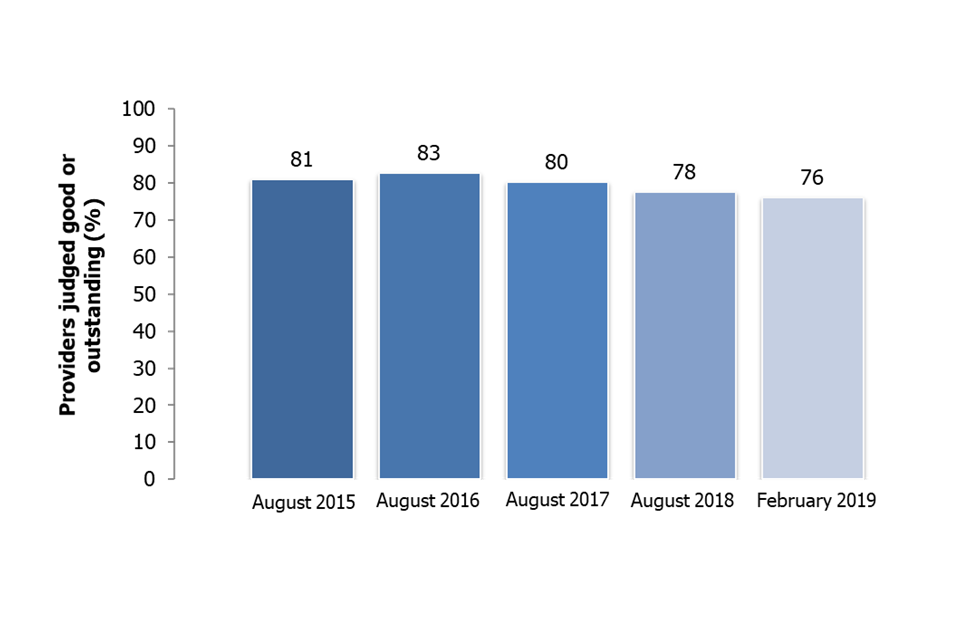
3.2 General further education colleges
The proportion of general FE colleges judged good or outstanding at their most recent inspection increased by 3 percentage points.
Between 1 September 2018 and 28 February 2019, 24 general FE colleges were inspected, with 54% judged good or outstanding. This is 15 percentage points lower than last year, which is a result of no short inspections having been carried out.
However, if you compare the outcomes from only full inspections the difference is less stark. Between 1 September 2018 and 28 February 2019, 24 general further education colleges had a full inspection, of which 54% were judged good or outstanding. This is 6 percentage points lower compared with last year.
Eight colleges previously judged good or outstanding were identified through risk assessment for inspection this year. Six out of the 8 declined to requires improvement at inspection.
Fourteen colleges previously judged requires improvement received their next routine full inspection. Nine of these colleges were successful in improving to good.
In addition, 2 colleges were inspected for the first time and were judged to be good.
Table 2: General further education college inspection outcomes between 1 September 2018 and 28 February 2019, by previous overall effectiveness and type of inspection
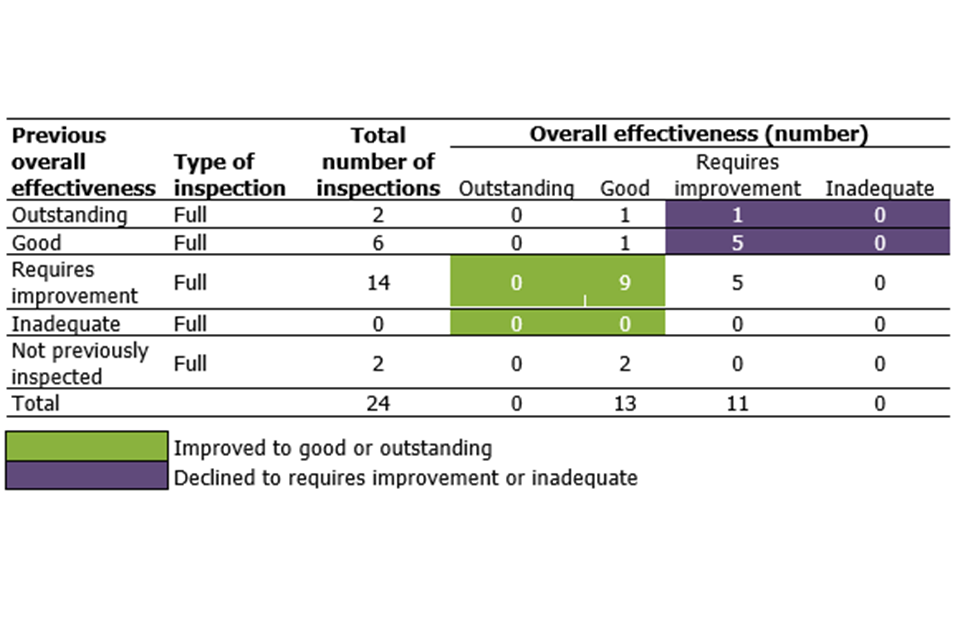
Despite the inspection outcomes being lower so far this year compared with last reporting year, the number of colleges improving, and the 2 colleges judged good at their first inspection, outweighed those that had declined this year. This meant that the proportion of general FE colleges judged good or outstanding at their most recent inspection increased by 3 percentage points, to 78% on 28 February 2019.
3.3 Other further education and skills providers
Table 3: Summary of main findings for provider groups with between 5 and 15 full inspections
| Provider group | No. of providers on 28 February 2019 | No. of inspections 1 Sept 2018 to 28 Feb 2019 | Main findings |
|---|---|---|---|
| Community learning and skills (CLS) providers | 218 | 11 full inspections | Seven providers improved from requires improvement to good. This improvement increased the proportion of CLS providers judged good or outstanding at their most recent inspection from 88% on 31 August 2018 to 91% on 28 February 2019. |
| Independent specialist colleges (ISCs) | 97 | 12 full inspections | There was an equal number of previously good ISCs risk assessed for a full inspection that declined at inspection this year, compared with the number of previously requires improvement ISCs that improved. Overall, the proportion of ISCs judged good or outstanding at their most recent inspection as at 28 February 2019 was 77%. On 28 February 2019 there were 97 ISCs, an increase of 17 compared with 31 August 2018. |
| Higher education institutions (HEIs) | 68 | 9 full inspections | All 9 HEIs inspected this year were judged good or outstanding. This included 4 HEIs that were being inspected for the first time. Of the 31 HEIs that had been inspected on 28 February 2019, 94% were judged good or outstanding. On 28 February 2019 there were 68 HEIs overall, this is 8 more than there were on 31 August 2018 and continues the pattern reported in the last release of these official statistics. |
| Sixth form colleges | 57 | 7 full inspections | Three sixth form colleges improved from requires improvement to good at inspection this year. This improvement increased the proportion of sixth form colleges judged good or outstanding at their most recent inspection to 89%, 8 percentage points higher than on 31 August 2018. |
| 16 to 19 academies | 50 | 6 full inspections | Two good sixth form colleges converted to become 16 to 19 academies, and 2 pre-existing 16 to 19 academies improved from requires improvement to good at inspection this year. This increased the proportion of academies judged good or outstanding at their most recent inspection to 83%, 4 percentage points higher than on 31 August 2018. |
3.4 Prisons and young offender institutions
The proportion of prisons and young offender institutions judged good or outstanding at their most recent inspection remains 48%.
On 28 February 2019, there were 114 prisons and young offender institutions (YOIs). All the prisons and YOIs had been inspected.
Ofsted contributed to 21 prison and YOI (YOI) inspections where the reports were published between 1 September 2018 and 28 February 2019. Six of the prisons and YOIs were judged good for overall effectiveness of education, skills and work (overall effectiveness)[footnote 2], 9 requires improvement and 6 inadequate. None were judged outstanding.
For 2 of the 21 prisons and YOIs, this was the first time they had received an overall effectiveness judgement since it was introduced in March 2014. One was judged good and the other requires improvement.
Nineteen of the prisons and YOIs had been inspected before. Four of those prisons and YOIs improved from requires improvement to good and 4 declined from good to be judged requires improvement or inadequate. Of the 8 prisons previously judged requires improvement that did not improve, 5 remained requires improvement and 3 declined to inadequate.
Table 4: The overall effectiveness of education, skills and work in prisons and young offender institutions published between 1 September 2018 and 28 February 2019, by previous overall effectiveness grade
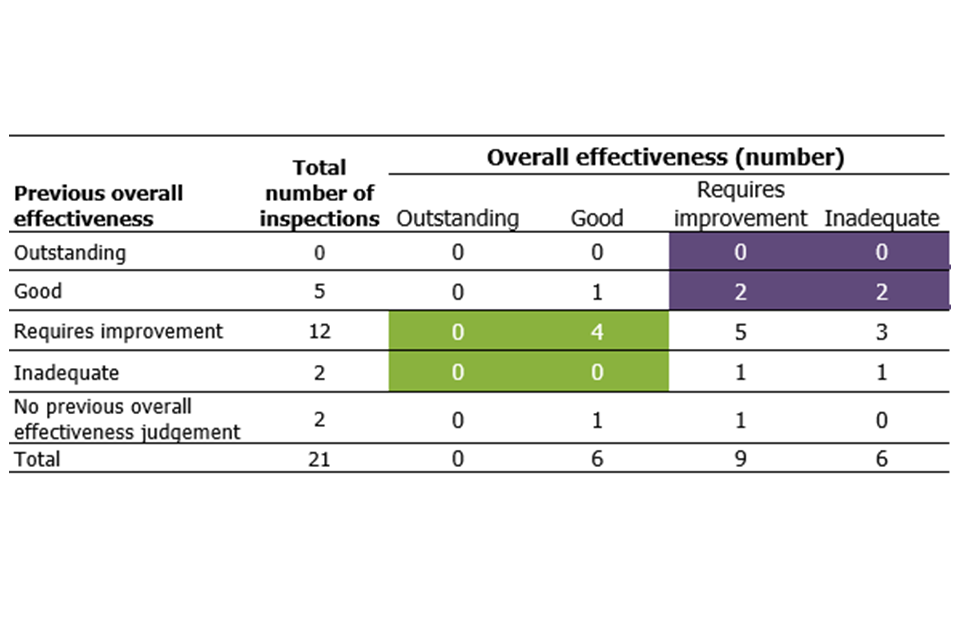
Overall, the same number of prisons improved to be good as those that declined to be less than good. Therefore, the in-year inspection outcomes did not affect the proportion of prisons and YOIs judged good or outstanding for overall effectiveness at their most recent inspection, which remains 48%. However, the proportion judged inadequate increased by 3 percentage points.
Figure 7: Overall effectiveness of education, skills and work in prisons and young offender institutions at their most recent inspection, over time
![[18/07/2019 15:18] Bar chart displaying inspection outcomes of prisons and young offender institutions at their most recent inspection over time.](https://assets.publishing.service.gov.uk/media/5d3086abe5274a14f6df1b12/Overall_effective_of_prison_over_time.png)
4. Revisions to previous release
4.1 In-year statistics
Alongside these Official Statistics a revised provider level dataset has been published, which includes inspections carried out between 1 September 2017 and 31 August 2018. This is due to Ofsted publishing additional monitoring visit reports since the previous iteration of these statistics. These changes do not affect the overall messages of the main findings or the tables and charts as previously reported.
Revisions to data in this publication are published in line with Ofsted’s revisions policy for official statistics.
5. Notes
5.1 Full inspections
Providers judged outstanding at their most recent inspection are not normally subject to routine inspection.[footnote 3] However, an outstanding provider may be risk assessed to receive a full inspection where its performance declines or there is another compelling reason, such as potential safeguarding issues.
Providers judged good for overall effectiveness at their most recent inspection will usually be inspected within the 3 years from September 2015. This will normally be a short inspection (see below) but may be a risk-assessed full inspection where information suggests that this is the most appropriate course of action, for example if the provider’s performance has declined.
A provider judged to require improvement at their most recent inspection will normally have a full re-inspection within 12 to 24 months.
Ofsted will monitor providers judged as inadequate and re-inspect them within 15 months of publication of their last full inspection report.[footnote 4]
5.2 Short inspections
Providers awarded a grade of good for overall effectiveness at their previous inspection will usually receive a short inspection.
A short inspection will determine whether the provider continues to provide a good standard of education/training for learners and whether safeguarding is effective.
A short inspection will not make individual graded judgements and will not change the provider’s overall effectiveness grade.
The lead inspector can choose to convert the short inspection to a full inspection where:
- there is insufficient evidence to confirm that the provider remains good
- there are concerns that there is evidence that the provider may no longer be good, which may include concerns about safeguarding
- if there is sufficient evidence of improved performance to suggest that the provider may be judged outstanding
If the inspection is converted to a full inspection, inspectors will make the full set of graded judgements. As a result of the converted inspection the provider could improve, decline or remain the same
The quality report for these official statistics contains an explanation of the methodology used and the relevant inspection frameworks, along with other useful information.
6. Glossary
6.1 General further education colleges
General further education colleges offer a range of education and training opportunities for learners aged from 14 years upwards, including adults. They include tertiary colleges, which specialise in land based education and training.
6.2 Sixth form colleges
A sixth form college is an educational institution where students aged 16 to 18 typically study for advanced school-level qualifications, such as A levels, or school-level qualifications such as GCSEs.
6.3 Specialist further education colleges
Specialist further education colleges are colleges who specialise in the provision of agricultural, horticultural or art, design and technology courses.
6.4 Independent specialist colleges
Independent specialist colleges provide education and training for students with complex learning difficulties and/or disabilities, whose learning needs cannot be met by their local college or provider.
6.5 Independent learning providers (including employer providers)
Independent learning providers are companies which provide government funded education. The category includes employer providers who only offer government funded training to their own employees.
6.6 Community learning and skills providers
Community learning and skills providers include local authorities, charities, voluntary, not for profit companies and community organisations, specialist designated institutions and community interest companies. Their provision is diverse in character and aims to meet the needs and interests of a wide range of communities. Courses include: those that lead to a qualification; programmes leading to qualifications whilst in employment (such as apprenticeships); provision for informal adult learning; and provision for social and personal development. Community learning and skills providers were previously categorised as adult and community learning providers.
6.7 16 to 19 academies
These are state-funded, non-fee-paying schools independent of local authorities which cater for pupils aged 16 to 19.
6.8 Dance and drama colleges
Colleges that specialises in delivering dance and drama courses.
6.9 Higher education institutions
Where higher education institutions (such as universities) offer further education courses and/or level 4 or 5 apprenticeships, these are subject to inspection by Ofsted.
6.10 National Careers Service contractors
The National Careers Service provides information, advice and guidance for those aged 13 and over across England. The service is delivered in 12 geographical regions by area based prime contractors and a national contact centre by a national contractor.
6.11 Prisons and youth offender institutions
Ofsted undertakes inspections in prisons and youth offender institutions in partnership with Her Majesty’s Inspectorate of Prisons (HMIP). Ofsted inspectors evaluate the quality of education, skills and work in prisons and young offender institutions. Inspection reports can be found on the HMIP website
7. Further information
7.1 Contact for comments or feedback
If you have any comments or feedback on this publication, please contact Sarah Pearce on 03000 130 632 or Sarah.Pearce@ofsted.gov.uk
7.2 Acknowledgements
Thanks to the following for their contribution to this statistical release: Stuart Lloyd, Simon Gilson, John Hadler and Kieran Rudge.
-
The following provider types remain subject to routine inspection when judged outstanding: higher education institutions offering further education, local authority providers, independent specialist colleges and dance and drama colleges. ↩
-
Previously known as ‘learning and skills and work activities’ ↩
-
The following types of provision are still subject to routine inspection when they have been judged outstanding: higher education institutions offering further education; local authority providers; independent specialist colleges; dance and drama colleges; and learning and skills provision in prisons. ↩
-
Full re-inspections or re-inspection monitoring visits may not happen in certain circumstances, for example where a provider’s funding contract has been terminated. ↩

